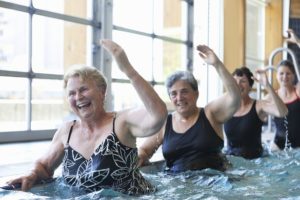Today I am addressing new trends in Physical Therapy. As the baby boomers are aging, the trend is Get Moving.
New Trends in Physical Therapy
When it comes to rehab from surgery or an injury, it’s a whole new ball game these days. Gone are long stretches of bed rest and weeks off from work. Today, doctors want you going right away with a round of physical therapy. That’s because research suggests it’s safe and leads to a speedier, better recovery.
“Treatment has become more aggressive,” says Kosta Kokolis, PT, clinical director of TheraMotion Physical Therapy Studio in New York. He says today’s physical therapists try to create change and make corrections, instead of waiting for your body to take its natural course.
“We guide the healing process,” he says.
Get Moving

In the past, your doctor would tell you to wrap your injured area to keep it still, Kokolis says. He would also suggest you take a break from your regular activities and rest in bed. But research flipped that way of thinking. Studies show that people who are active during recovery do better than those who take it easy.
Dan Collins, a 53-year-old media relations professional in Baltimore, is a shining example. He bounced back quickly after a spinal disc laminectomy.
“I believe much of that has to do with the fact that they get you up and moving ASAP,” he says. “I went right into physical therapy the morning after my spinal surgery.”
Years ago, if you had shoulder surgery to fix a torn rotator cuff, you might wear a sling for 6-8 weeks and hold off on physical therapy until 4-6 weeks. “Now my patients are usually out of the sling, except when sleeping, and start physical therapy by the end of the first week,” says Brian Schulz, MD, an orthopedic surgeon and sports medicine specialist at Kerlan-Jobe Orthopaedic Clinic in Los Angeles.
Doctors today want you to start building your strength back up as soon as possible. The idea, Kokolis says, is simple: Use it or lose it.
Hands-on Techniques
In the past, your physical therapist may have relied on treatments like electrical stimulation, ultrasound, or iontophoresis to treat your pain. “But that doesn’t really resolve your problem,” Kokolis says. “It doesn’t correct or fix anything.”
Hands-on Techniques continued…

Today, physical therapists take a more hands-on approach. They prefer manual therapy, also called bodywork, to get to the source of your pain and correct the issue. It helps with relaxation, flexibility, and pain relief.
For instance, your therapist may use skilled massage or manipulate your bones and joints with careful, controlled force. He may do exercises that twist, pull, or push your bones, to improve your range of motion.
Today, therapists are more likely to push your body’s limits. They may sometimes want you to feel some pain, instead of avoiding it.
Limit Your Use of Assistive Devices
A few decades back, if you had lower back problems, your doctor may have told you to wear a brace. If you mowed the lawn, for example, you’d strap it on for extra support. If you had a neck injury, you may have worn one while driving.
Today, assistive devices like braces, canes, crutches, splints, or special footwear are still used when necessary. But they’re no longer go-to items.
“We try to use them as little as possible,” Kokolis says. Therapists now understand that keeping the injured area still actually makes it weaker.
Return to Your Regular Activities – But Be Safe
In the past, the main goal of rehab was to increase your range of motion. If you had shoulder surgery, for example, your therapist would try to help you get back to moving it a full 180-degrees.
But hitting that number doesn’t guarantee you can do everything you’d like to do, whether it’s cleaning your house or playing tennis. And even without a full range of motion, you may function just fine.
So therapists shifted their focus to making you able to use your joint better. Now the goal is to get you back to your regular activities. At first, it may be getting you to the point where you can dress yourself or brush your hair. That may lead to walking, going up stairs, or lifting things.
For Collins, picking up his sports equipment to pursue his passion was the ultimate success. “I was eventually able to return to my sport — fencing,” he says. And that, he adds, was therapy in and of itself.
Our goal at Integrative Therapy and Wellness, LLC is to come to you to help you get moving and Engage in Life. After an illness, surgery or acute illness our team will come to your home in the Phoenix area and do a comprehensive assessment to help you get Moving and regain your independence. Please contact Kim at kim@integrativetherapywellness.com for more information.
https://integrativetherapywellness.com
Thanks for Reading,
Kim Jacob

